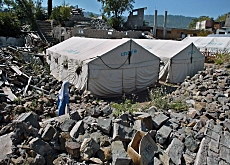
Swiss help with quake reconstruction efforts

Close to 400,000 people face a second winter without permanent shelter following last year's earthquake in the mountains and valleys of northern Pakistan.
One year on, Swiss aid workers are battling to help survivors rebuild their lives, focusing on the reconstruction of permanent homes, schools and healthcare centres, while facing the prospect of a difficult winter ahead.
The 7.6-magnitude earthquake on October 8, 2005, ripped through northwest Pakistan and Pakistani Kashmir, killing 88,000 people, injuring 100,000 and rendering more than two million people destitute.
The Swiss Agency for Development and Cooperation (SDC), which ended its relief effort in Pakistan in February to concentrate on reconstruction work, told swissinfo that there was still a lot of work to be done.
“About 600,000 houses were destroyed in the earthquake zone, as well as 6,000 schools, hundreds of basic health units and thousands of kilometres of road,” said Edwin Brunner, the SDC humanitarian aid coordinator for Pakistan.
The coordinator said the main problem were families living in inaccessible rural areas, who had either stayed in the region after the earthquake or returned earlier this year. The Red Cross estimates that around 66,000 families are still living in temporary shelters.
Brunner said most people should be safe enough in the shelters and that they had stocked up on food. But it was still unclear how harsh the winter would be.
He added that there were still around 30,000 people, who were mostly desperately poor, living in camps. Contingency plans have been made for an expected influx of 10,000-20,000 extra people during the winter.
In all, Brunner described the situation as “relatively under control”. “These people are extremely tough, they are used to surviving in harsh conditions and I do not expect any major problem there.”
Reconstruction
Brunner said most schools and health units were functioning in temporary buildings and the reconstruction of permanent new schools had started in some places, although often bogged down by bureaucracy.
The SDC is due to start rebuilding a dozen schools in the North-West Frontier Province on the anniversary of the earthquake.
“It took us six months to consult with all the parties involved on how they should be rebuilt,” explained Thomas Fisler, head of the SDC’s reconstruction team in Mansehra.
And another six months were needed to get the correct paperwork, admitted Fisler. The SDC plan to construct a total of up to 50 schools and healthcare centres. The Protestant charity Swiss Interchurch Aid was slightly more fortunate. It started rebuilding 15 schools in March thanks to local contacts, and two others are planned at the start of 2007.
The SDC is also taking part in the vast government programme to rebuild around 400,000 homes. The agency is playing a coordinating role at two housing reconstruction centres – in Balakot and Batagram – where training is being given in earthquake-resistant design techniques.
And Swiss aid workers have started working on livelihood support projects, helping communities to resume livestock farming and cultivation. SDC expects to continue its humanitarian aid in the region until at least 2008.

More
Swiss Agency for Development and Cooperation (SDC)
ICRC
The Swiss-based International Committee of the Red Cross (ICRC), which has been in the area since 1981 via its partner the Pakistan Red Crescent Society, has assisted some 220,000 people since last year.
“The organisation set up one of the biggest helicopter operations in its history,” said Régis Savioz, deputy head of ICRC operations for Central and Southern Asia.
Nine helicopters evacuated some 1,000 patients in need of hospital treatment. A field hospital was also set up and operational up until February in Muzaffarabad, the capital of Pakistani-administered Kashmir, and an orthopaedic centre is due to open there in 2007.
The ICRC says it will remain in the region for another two or three years especially to make sure women and children have access to essential healthcare. Like the SDC, it has also been helping families resume livestock farming and plans to provide over 6,000 head of cattle by the end of 2007.
swissinfo
On October 8, 2005 an earthquake measuring 7.6 on the Richter scale struck the northern Pakistan/Kashmir region, resulting in at least 88,000 deaths in Pakistan, India and Afghanistan, and over 100,000 injured. In Pakistan alone around 2.5 million people lost their homes.
The rugged topography of the affected areas, combined with a scattered settlement pattern, poor quality of construction and the lack of seismic-resistant building designs, pose significant challenges for both humanitarian and reconstruction efforts.
The SDC, in cooperation with its Swiss partners, is focusing on the reconstruction of schools, healthcare centres and farms. Also, it is promoting earthquake preparedness and earthquake-proof building techniques.
To date, the SDC has provided a total of SFr22 million in response to the South Asia earthquake: SFr7 million for emergency assistance and SFr7 million for reconstruction in Pakistan. An additional SFr8 million has been channelled through UN organizations and the ICRC.
The SDC’s “Reconstruction and Livelihood Programme” in Pakistan is being run by nine Swiss humanitarian aid experts and 43 local staff.
ICRC Pakistan operation: SFr60 million budget and 50 expatriate delegates.
Swiss Solidarity collected SFr12 million for victims of the earthquake, of which SFr9.6 million was spent on temporary shelter for 200,000 people.

In compliance with the JTI standards
More: SWI swissinfo.ch certified by the Journalism Trust Initiative

















![The four-metre-long painting "Sonntag der Bergbauern" [Sunday of the Mountain Farmers, 1923-24/26] had to be removed by a crane from the German Chancellery in Berlin for the exhibition in Bern.](https://www.swissinfo.ch/content/wp-content/uploads/sites/13/2025/12/01_Pressebild_KirchnerxKirchner.jpg?ver=a45b19f3)











You can find an overview of ongoing debates with our journalists here . Please join us!
If you want to start a conversation about a topic raised in this article or want to report factual errors, email us at english@swissinfo.ch.